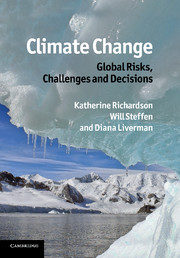Book contents
- Frontmatter
- Contents
- Writing team
- Foreword
- Preface
- List of acronyms and abbreviations
- Part I Climatic trends
- Part II Defining ‘dangerous climate change’
- Part III Equity issues
- Part IV Mitigation and adaptation approaches
- Part V Meeting the challenge
- 15 Integrating adaptation, mitigation and sustainable development
- 16 Mobilising the population
- 17 The human–Earth relationship: past, present and future
- Index
- Plate section
- References
16 - Mobilising the population
Published online by Cambridge University Press: 04 April 2011
- Frontmatter
- Contents
- Writing team
- Foreword
- Preface
- List of acronyms and abbreviations
- Part I Climatic trends
- Part II Defining ‘dangerous climate change’
- Part III Equity issues
- Part IV Mitigation and adaptation approaches
- Part V Meeting the challenge
- 15 Integrating adaptation, mitigation and sustainable development
- 16 Mobilising the population
- 17 The human–Earth relationship: past, present and future
- Index
- Plate section
- References
Summary
‘Never doubt that a small group of thoughtful, committed citizens can change the world; indeed, it's the only thing that ever has.’
An effective response to the risks of climate change can build on the ideas and actions of many different individuals – both as citizens and consumers, and as leaders of business and other organisations. Individual citizens can play an important role in the response to climate change, especially when they make decisions to reduce their greenhouse gas emissions or adapt to climate change encouraged by institutional structures and access to credible, understandable and relevant information. There is considerable evidence that individual behavioural change can contribute to reductions in emissions, especially from households and transportation and when supported by government policies, incentives and private sector activities.
Individuals are also engaged with climate change as decision-makers, members of non-governmental organisations (NGOs) and voters in ways that influence the actions of governments and corporations. Public support is critical in the success of national and regional government actions, and public perceptions can impede the acceptance of mitigation technologies. Behavioural and attitudinal changes are also important in terms of political and corporate leadership where, for example, business leaders and city mayors have made significant commitments to emission reductions that go far beyond national political obligations or simple cost–benefit analysis. In terms of adaptation, millions of farmers and herders have adjusted their practices to past climate shifts and are already making decisions in response to the onset of warming and other shifts associated with climate change.
- Type
- Chapter
- Information
- Climate Change: Global Risks, Challenges and Decisions , pp. 451 - 471Publisher: Cambridge University PressPrint publication year: 2011



